The X Button
Tales Told
by Todd Ciolek,

This week finds the Neo Geo X on the horizon. A repackaging of SNK's long-lived Neo Geo console, the X has very little advertising. It contrasts with the way the original Neo Geo arrived back in 1991. The system was arcade hardware redesigned for the home, and so it cost about $649.99 (over $1000 with inflation adjusted) and took game carts that ran $200 apiece. This put SNK's marketers in a bind. The Neo Geo was well beyond the price range of kids who scraped together fifty bucks for a Genesis or Super NES game a few times a year, and parents wouldn't be won over. How then could SNK sell the Neo Geo?
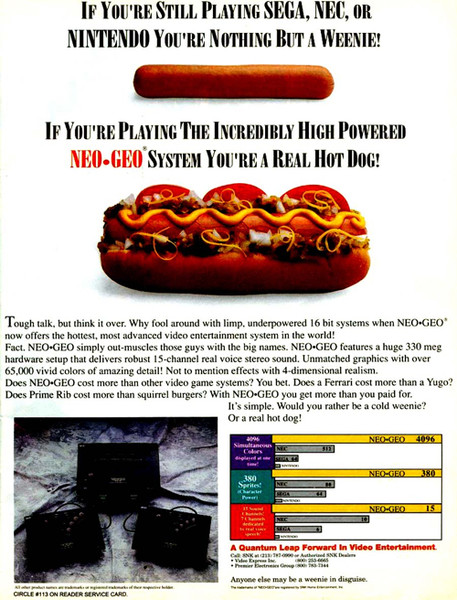
SNK went on the attack. Early Neo Geo ads extolled the system's superior capabilities, touting hardware specs and things like “4-dimensional realism.” They were partly right. The Neo Geo couldn't travel in time, but it moved 2-D graphics like no other console could. SNK was gunning for the older, richer types who would assume that a system's hardware and price tag made it innately better, just like bigger TVs and faster sports cars.
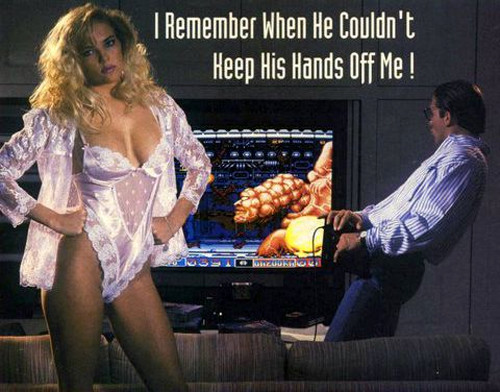
This became even more apparent in other Neo Geo marketing. We've all seen the above ad (which ran in Playboy and similar publications), and some American Neo Geo games bore a logo with a dog slobbering over the words BIGGER, BADDER, BETTER. It was the game equivalent of those Big Johnson shirts that high school kids were wearing back in 1993.
The idea didn't pay off as well as SNK hoped. The Neo Geo never posed a threat to Sega or Nintendo, and the system soon slipped into a niche. Yet the bigger-is-better theme helped it win a remarkably devoted fan following. Those fans weren't great in numbers, but their disposable income kept the Neo Geo viable until 2004, even pulling it through the death and revival of SNK itself. So there's something to be said for phallic advertising and tasteless innuendo.
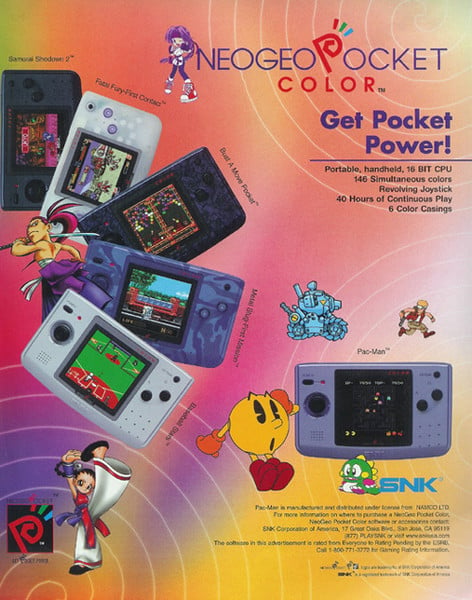
On the other hand, the Neo Geo Pocket Color had much more family-friendly marketing. Due to SNK's collapse and predatory corporate buyouts, the handheld lasted only a few years. I maintain that it was a much more interesting system than its bigger, badder predecessor, but that's a story for another time.
NEWS
WII MINI ANNOUNCED, SHIPS TO THE LAND OF POUTINE NEXT WEEK
It's been far too long since Nintendo redesigned a console. New versions of Nintendo handhelds ship just about every season, but Nintendo hasn't remodeled a home system drastically since the Super NES. The Wii Mini is a similar reissue of a console now surpassed, but it's scaled down far more than the smaller Super NES and NES ever were.

Aside from a top-loading design, the Wii Mini ditches two notable features of the original Wii. It's not compatible with Gamecube titles or controllers (no surprise there, since the most recent Wii model wasn't either), and it can't connect to the Internet. This means that Nintendo's Virtual Console and WiiWare services are apparently no good on the Wii Mini. It's also $100, a mere $50 less than the Wii bundle that comes with New Super Mario Bros. Wii.
On a curious note, the Wii Mini is confirmed only for a Canadian release next week. It'll likely filter out to other markets after that. But will it have a pack-in game?
SEGA SHOWS OFF YET ANOTHER 7TH DRAGON RPG THAT PROBABLY WON'T COME HERE
It seems odd to call Sega's new RPG 7th Dragon 2020-II. For one thing, it's set in 2021, a year after the floral outbreak that overran Tokyo in 7th Dragon 2020. Perhaps Sega wants to underscore just how much this sequel takes after 7th Dragon 2020. It's another battle-heavy RPG set in the flower-covered ruins of Japan's largest city, where mutants and alien dragons are once again attacking humankind.
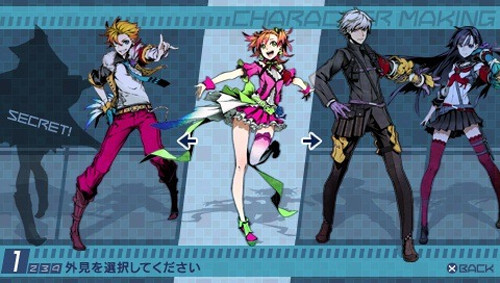
This new 7th Dragon retains the big-headed characters and classes of the two previous games, though the customization options are expanded. Players can choose from 40 different voice actors and actresses when designing party members, and the jobs now include an “idol” class alongside the hackers and psychic mages and street samurai. Idols are gifted with exceptionally high charisma, which seemingly lets them order around foes and other characters with the power of pop-stardom.

Sega scheduled a spring release for 7th Dragon 2020-II in Japan, where it'll arrive on the PSP and PlayStation Network. None of the earlier 7th Dragon games showed up here, and that doesn't bode well for an American release this time around. Perhaps there's more hope for Sega's recently trademarked 7th Dragon 2020 3rd Encount.
SCREENSHOTS OF THE WEEK: SEGA'S AM2 FIGHTERS
Sega's latest resurrection involves three fighting games from the mid-1990s, when the company's AM2 division cranked out a bunch of 3-D fighters for the arcade. Some were more popular than others. Virtua Fighter 2 was commonplace, but it was harder to find a Fighting Vipers machine in North American arcades—and rarer still to encounter a Sonic the Fighters unit. Well, now all three of them are on the PlayStation Network for five bucks each, with Live versions to follow later this week.

Sonic the Fighters is the most obscure of these, and it's best summed up by an image of happy, smiling Sonic characters smacking each other around. The game's basic play recalls Virtua Fighter, but this Sonic slapfest lets players trade protective barriers for better combo attacks. It's also a weird look at just where Sonic stood in 1996; Sega had yet to invent Shadow or Silver or other hedgehog, so the roster is filled out by a polar bear named Bark and the bomb-throwing duck from Dynamite Dux. The PSN and Live versions of the game even restore a previously unused character called Honey the Cat, which brings us to…

Fighting Vipers was Sega's follow-up to Virtua Fighter, possibly created to counterbalance that game's bland character designs. Despite being programmed in 1995, Fighting Vipers has the most hysterically '80s roster ever, with a rollerblader, a glam rocker, a skateboarding kid, a clone of Vasquez from Aliens, and a frilly fashionista named Candy (a.k.a. Honey) all doing battle. It's also a solidly brutal fighter that pioneered such ideas as breakable armor and the art of punching opponents through walls. Sadly, this version lacks the Pepsiman cameo from the Sega Saturn port.
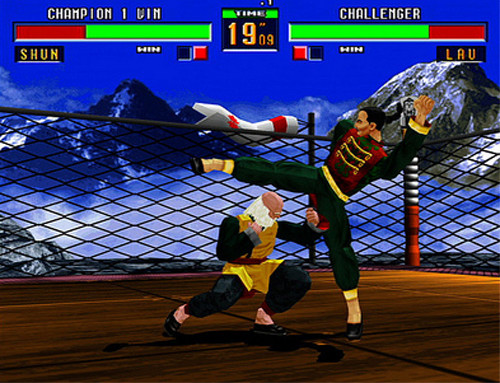
Virtua Fighter 2 is the both the most refined and least essential of the three games. It's the best-known of Sega's fighters, but it's also been outpaced by subsequent Virtua Fighters in every way that counts. Yet I have no doubt that devoted Virtua Fighter fans will find some rewarding qualities in it. It also helps if you're nostalgic for that one X-Files episode where Giovanni Ribisi electrocutes a guy for interrupting his game of Virtua Fighter 2.
INTERVIEW: TALES' HIDEO BABA
Namco's Tales series had a rocky start. Tales of Phantasia somehow survived development revisions and staff disputes to arrive as a late Super Famicom release in 1995. Namco followed it with Tales of Destiny on the PlayStation, and from there the series steadily grew to become a reliable success in Japan's game industry. Right behind Dragon Quest and the now-troubled Final Fantasy, Tales is the third biggest J-RPG franchise currently running.
And Hideo Baba is in charge of it. As the producer and brand manager of the Tales series, Baba makes a lot of the big decisions that drive the latest Tales titles. And with the ambitious Tales of Xillia set to arrive on the PlayStation 3 in North America next year, the franchise might gain a new lineup of English-speaking fans. So we asked Baba a few questions about where the Tales games are going.
How did you come to work at Namco Bandai?
I used to be at a company which worked on the flight sim Sidewinder Max. I'm not sure if the company exists any more. And I joined Namco for action-adventure games like Death by Degrees.
Recently Namco Tales Studio was dissolved. How did this affect development of the series?
Basically there's no big change. All of the members of the Tales Studio came together to work in the same building, so they can now communicate with other development teams, like those for Tekken or Soul Calibur.
Do you still have different teams working on different games, or do you form a different team every time a new game is developed?
As you said, there were several teams in the studio up until about five years ago. To put it simply, there were teams that were strong in making 2-D games, and others that were good at making 3-D games. But now we just collect the staff to develop a new title every time.
Older Tales games like Phantasia, Destiny, and Symphonia have strong fantasy elements, but Tales of Xillia has a slightly more modern look. What was your inspiration for that?
Of course, the appearance of the game changes, but the storylines have a common theme. The graphics are 3-D and more improved [in Xillia]. In the previous games, the characters were more super-deformed and shorter than actual people. But in the most recent games, the characters' height is…well, not photorealistic, but it's closer to a real person. Tales of Xillia 2 features a very modern-culture world different from previous Tales games. The first Xillia, Graces, and Vesperia also feature more modern worlds.

What was the major inspiration for Tales of Xillia 2's world?
Tales of Xillia 2 is a sequel, so I wanted to put some new atmosphere into it. I was inspired by London and Russia from the 19th century, and I wanted to have a natural feel.
Some fans felt that Tales of Vesperia had darker themes than other games in the series, touching on the value of personal responsibility and the consequences of not living up to it. Will future Tales games go down that path?
For each title, we come up with a different theme, so it could be something serious or something casual.
What's the theme of Tales of Xillia 2?
The key word is “selection.” In our daily life, we make choices that change the future, and this is portrayed in the game.
In the Tales games, you generally have the male lead as a swordfighter, while the heroine uses healing magic. Tales of Xillia seems to reverse this, since Milla Maxwell wields swords and Jude Mathis has healing spells. What was the reason for that?
One big reason was Milla's character. She's a mentally mature character, and to reflect that I decided that she would use a sword instead of being a healing character. Jude doesn't have a sword, but he's a fistfighter as well as a healer, since he's studying to be a doctor.
The roles seem to be switched back in Xillia 2, where the hero is a grown man and the heroine is a young girl. Why change them around?
By having an adult main character, we wanted to convey the heavy responsibility of his “selection.”
So the hero, Ludger, has made a lot of his choices in life, and the eight-year-old girl, Elle, hasn't?
Well, in Tales of Xillia, Milla and Jude are both the leads, but in Xillia 2, the girl is to be protected by the hero. So she doesn't make many selections.

Fewer than ten Tales games have been released in North America. How do you decide on which games to release here?
The biggest market for the Tales series is still Japan, so our top priority is to develop a new title for the Japanese market. And the Tales teams have a limited number of members, so the member need to prioritize when they develop a Western version of the game. But from now on, I want to release as many Tales games as I can in North America.
What would you say are the most popular Tales games in each region?
In the European and North American markets, I think Tales of Symphonia is the most popular. In Japan, it's harder to answer. But when we brought out Tales of Xillia in Japan, we had so many new users that I think it must be one of the most popular.
Tales of Xillia is the next game scheduled for America. How do you think its Dual Raid Linear Motion Battle System stands apart from the combat in previous Tales titles?
One of Xillia's biggest points is that there are two lead characters, Jude and Milla. So the new battle system allows players to link two characters together for helping each other in battle.

How do you come up with the names for Tales battle systems, anyway? Do you start with the name and work back from it?
First we come up with the idea, and after fixing all of the details, we come up with the name for it.
Many Tales game allow cooperative play in battles, but none of them has online multiplayer. Will any future Tales games have that?
We don't have any plans for online features in the Tales games. If the players can select their favorite characters, just imagine if there were one hundred or two hundred Judes and Millas. The Tales series is difficult to fit with online features, so I want the players to enjoy the game offline.
Will we see North American releases for the fighting game Tales of VS. or the battlefield brawler Tales of the Heroes: Twin Brave, as they're more action-oriented?
Actually, the battle system of VS. is based on the original Tales battle system, so it's a bit different from what the action-game players in the U.S. might expect. One of the major selling points is that the player can control their favorite Tales characters.
So who's your favorite Tales character?
It's a difficult question to answer, but if I need to pick one, it'd be Leon Magnus from Tales of Destiny. I'm very impressed with how he spent his life.
NEXT WEEK'S RELEASE
THE NEO GEO X Developer: SNK/Blaze Europe
Developer: SNK/Blaze Europe Publisher: Tommo/SNK Playmore MSRP: $129.99/$199.99 It's a fair point that the Neo Geo X isn't a new game system, at least not in the same sense as the PS Vita or the Wii U. This is a repackaging of SNK's cult-worshipped Neo Geo console. Released in 1991, the bulky, pricey unit was a home version of SNK's arcade hardware, resulting in Neo Geo games that were exactly the same as their arcade counterparts. The experience didn't come cheap, and many were put off by the $650 console and the quick-burning style of many SNK arcade offerings. But plenty of kids wanted a Neo Geo all the same, and the Neo Geo X seems styled for that audience. The actual Neo Geo X is a handheld, with a 4.3-inch screen, a stubby joypad, four face buttons, shoulder buttons, and a slot for game cards. It resembles a bulkier version of the Neo Geo Pocket Color, so it's two nostalgia doses in one. One can also shell out $200 for the bundle with the system and its docking station, which resembles a Neo Geo deck. It lets the Neo Geo X connect to a TV and use a full joystick—an authentic-looking Neo Geo joystick, at that. Twenty games are built into the handheld, and it seems a promising offer until you consider the lineup. In recent years, SNK has carefully reissued its older Neo Geo titles instead of skipping to the newer, more interesting ones. So the Neo Geo X gets a smattering of well-aged games amid more archaic selections. Samurai Shodown II and World Heroes Perfect are the best of their particular series, but the same can't be said for The King of Fighters '95, King of the Monsters, Art of Fighting 2, or the first Metal Slug. And isn't it a bit much to include the original Fatal Fury, Fatal Fury Special, and Real Bout Fatal Fury Special? The rest of the pack-ins seem to be chosen for genre variety as much as actual quality, so you'll see mediocrities like NAM-1975, Cyber-Lip, 3 Count Bout, and Alpha Mission II alongside more respected Neo Geo staples like Magician Lord, Baseball Stars II, and the underrated League Bowling. And then we have Mutation Nation, Last Resort, Puzzled, and Super Sidekicks. They're not terrible, but the Neo Geo did better. Pre-ordering the system also gets you a game card with the middling fighter Ninja Master's (Ninja Master's WHAT?), with other old Neo Geo titles presumably set to arrive in the same format. That may not rebuild SNK's past glories, but the Neo Geo X might interest anyone who ever wanted the game industry's most expensive toy of 1991. |
Far Cry 3 will dominate next week as it hits the Xbox 360, PC, and PlayStation 3. Meanwhile, Guilty Gear XX Accent Core Plus arrives on the PlayStation Network, not so long after the Xbox Live version.
In portable news, DotEmu has an interesting shooter package with Raiden Legacy, which brings the original Raiden, Raiden Fighters, Raiden Fighters 2, and Raiden Fighters Jet to the iPhone and other iOS devices.
ARTBOOK GALLERY: DISGAEART!!!
 Disgaea did a lot of things right as far as the game industry of 2003 was concerned. It looked basic even then, but its strategy-RPG playfields and 2-D characters held unthinkable variety for the stat-obsessed, dungeon-hacking enthusiast. All of this was moved along by a warped vision of the afterlife, full of giant-eyed angels and demons who mocked their genre's conceits and occasionally indulged them. Takehito Harada's art was an undeniable force in that anime divine comedy, and he's been Disgaea's main illustrator through three sequels, three spin-offs, and all sorts of merchandise. Those games are chronicled in the excitably titled DISGAEArt!!! book, released here by Udon a few months ago.
Disgaea did a lot of things right as far as the game industry of 2003 was concerned. It looked basic even then, but its strategy-RPG playfields and 2-D characters held unthinkable variety for the stat-obsessed, dungeon-hacking enthusiast. All of this was moved along by a warped vision of the afterlife, full of giant-eyed angels and demons who mocked their genre's conceits and occasionally indulged them. Takehito Harada's art was an undeniable force in that anime divine comedy, and he's been Disgaea's main illustrator through three sequels, three spin-offs, and all sorts of merchandise. Those games are chronicled in the excitably titled DISGAEArt!!! book, released here by Udon a few months ago.
DISGAEArt!!! digs quite deep in rounding up commercial art from the four main Disgaea games and assorted ancillary projects. Amid the large, page-filling illustrations, you'll see telephone-card pieces, special-edition art, and character designs. The book also gathers art from a number of light novels that weren't released in the West, such as Disgaea: The Brave and the Maoh and Disgaea Three Dash. Like the Disgaea series itself, the artwork often favors the first game's trio of disgruntled ruler Laharl, bratty demon mistress Etna, and fallen angel Flonne. Disgaea fans will find everything mixed together, however, resulting in collages of faces from all four games; Rozalin and Sapphire pose with their handguns, Laharl and Mao grudgingly share space, and the whole cast lines up for hot-springs trips or school photos. Of course, that's all part of the Disgaea games, each of which borrows characters from other titles.
 Much of the art comes from Harada, who favors bright colors, cartoon proportions, and noses that are visible only in profile. That style's reflected by most of the other artists, including Hideki Ishikawa. Those with a low anime-eye threshold will be repulsed within pages, though some amusing departures break up the flow of Harada-brand cute. Some art envisions Disgaea's Captain Gordon and Jennifer as space-opera heroes straight out of 1960s pulps, while Toi Hachi contributes a nicely bleak illustration of squabbling supporting characters Axel and Asagi.
Much of the art comes from Harada, who favors bright colors, cartoon proportions, and noses that are visible only in profile. That style's reflected by most of the other artists, including Hideki Ishikawa. Those with a low anime-eye threshold will be repulsed within pages, though some amusing departures break up the flow of Harada-brand cute. Some art envisions Disgaea's Captain Gordon and Jennifer as space-opera heroes straight out of 1960s pulps, while Toi Hachi contributes a nicely bleak illustration of squabbling supporting characters Axel and Asagi.
The collection doesn't want for artwork, but it's lacking in background details. There are no production sketches showing early versions of Disgaea regulars, nor is any insight offered into the design process for the character—not even the franchise's recognizable demon-penguin Prinnies. There aren't any interviews or character profiles, and only a few four-panel comics appear throughout the book. DISGAEArt!!! has art and not much else. And that art's penchant for suggestiveness sometimes veers into creepy terrain. It's particularly bad with Etna, who looks all of eleven years old and wears bondage gear. That element has dogged Disgaea since its first title, and it's sadly evident in these pages.
DISGAEArt!!! lacks the in-depth studies found in other Udon-published artbooks, and anyone who dislikes the series will be reminded why after flipping through this collection. Yet for those who've sunk hundreds of hours into extra item-world dungeons and leveled up characters to the maximum, DISGAEArt!!!will serve quite well.
discuss this in the forum (33 posts) |
this article has been modified since it was originally posted; see change history